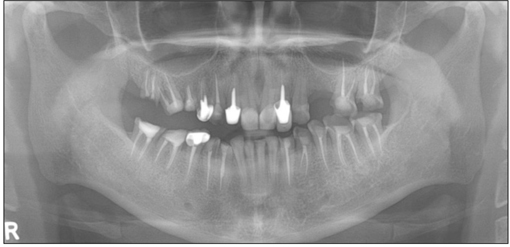J Korean Acad Prosthodont.
2012 Oct;50(4):324-329. 10.4047/jkap.2012.50.4.324.
Full mouth rehabilitation of the patient with severe tooth erosion using collarless porcelain fused to gold restorations: a case report
- Affiliations
-
- 1Department of Prosthodontics, School of Dentistry, Seoul National University, Seoul, Korea. silk1@snu.ac.kr
- KMID: 2195476
- DOI: http://doi.org/10.4047/jkap.2012.50.4.324
Abstract
- Excessive tooth wear causes loss of tooth structure, disharmony of occlusal plane, functional and esthetic problems. Although the decrease of occlusal vertical dimension may be compensated by growth of alveolar bone, if the length of tooth is not enough for the retention of restoration, minimum increase of occlusal vertical dimension is required without discomfort of the patient. In this case, 33-year-old woman drinks more than 1 liter of soft drinks a day and has bruxism in night time, visited in Seoul National University Dental Hospital with chief complaint of generalized tooth wear and related esthetic and functional problems. It was considered as a loss of occlusal vertical dimension based on the accelerated tooth wear caused by erosion and bruxism and facial appearance, phonetic, esthetic, functional evaluations. It was planned to raise occlusal vertical dimension by provisional restoration two times for patient's adaptation, 3 mm and 2 mm each, total 5 mm. Confirming no discomfort and clinical symptom during total 16 weeks after restoration with provisional fixed restoration, it was restored with porcelain fused to gold crown and bridge. Because the patient was young woman, anterior teeth were restored with collarless porcelain fused to gold crown. This case presents that satisfactory esthetic and functional result by full mouth rehabilitation with increase of occlusal vertical dimension.
MeSH Terms
Figure
Reference
-
1. Pindborg JJ. Pathology of the Hard Dental Tissues. 1970. Philadelphia: W. B. Saunders Company;294–311.2. Verrett RG. Analyzing the etiology of an extremely worn dentition. J Prosthodont. 2001. 10:224–233.
Article3. Turner KA, Missirlian DM. Restoration of the extremely worn dentition. J Prosthet Dent. 1984. 52:467–474.
Article4. Murphy T. Compensatory mechanisms in facial height adjustment to functional tooth attrition. Aust Dent J. 1959. 4:312–323.
Article5. Bartlett DW. The role of erosion in tooth wear: aetiology, prevention and management. Int Dent J. 2005. 55:277–284.
Article6. Davis WB, Winter PJ. The effect of abrasion on enamel and dentine and exposure to dietary acid. Br Dent J. 1980. 148:253–256.
Article7. Jaeggi T, Lussi A. Toothbrush abrasion of erosively altered enamel after intraoral exposure to saliva: an in situ study. Caries Res. 1999. 33:455–461.
Article8. Eisenburger M, Shellis RP, Addy M. Comparative study of wear of enamel induced by alternating and simultaneous combinations of abrasion and erosion in vitro. Caries Res. 2003. 37:450–455.
Article9. Attin T, Siegel S, Buchalla W, Lennon AM, Hannig C, Becker K. Brushing abrasion of softened and remineralised dentin: an in situ study. Caries Res. 2004. 38:62–66.
Article10. Michalakis KX, Stratos A, Hirayama H, Kang K, Touloumi F, Oishi Y. Fracture resistance of metal ceramic restorations with two different margin designs after exposure to masticatory simulation. J Prosthet Dent. 2009. 102:172–178.
Article11. Swati S, Chowdhary R, Patil PS. Marginal strength of collarless metal ceramic crown. Int J Dent. 2010. 2010:521470.
Article
- Full Text Links
- Actions
-
Cited
- CITED
-
- Close
- Share
- Similar articles
-
- Full mouth rehabilitation of a patient with tooth wear and insufficient restorative space due to loss of posterior teeth support: a case report
- A case of full mouth rehabilitation with orthodontic treatment in patient with extensive tooth erosion and wear using monolithic zirconia prostheses
- Full mouth rehabilitation on the patient with severe tooth wear and tooth fracture using reestabilishment of occlusal vertical dimension
- Functional and esthetical full mouth rehabilitation with implant supported prostheses: A case report
- Full mouth rehabilitation using zirconia crown in severe worn dentition: a case report






